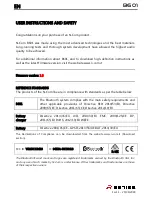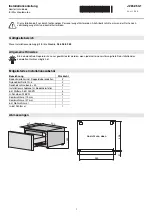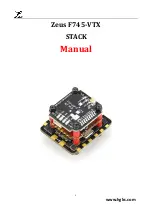
Series 2 Plug & Play EMS
3
© 2021 AEM Performance Electronics
INSTALLATION
**Read and understand these instructions
BEFORE
attempting to install this product.**
Sufficient Battery Voltage During Cranking (Starting)
Having enough battery voltage when you crank over your vehicle is critical to the operation of your vehicle and
your AEM EMS. For the EMS to function properly, the battery voltage must remain at or above 8 Volts when the
vehicle is first starting. This is the time when your electrical system will be worked its hardest and be at its lowest
voltage. If you are connected to your Series 2 EMS with a USB communications cable and you experience
disconnecting while the vehicle is cranking, the reason is most likely a battery voltage of less than 8 Volts. (See
the Channel called “Battery Raw” which is an unfiltered value of actual battery voltage being received by the
EMS.) If this is the case, you can confirm this by connecting with a serial cable (a serial adapter may be required
if your computer is not equipped with a serial port) and checking in the AEMTuner software for a Channel called
“Run Time,” as well as “Battery Raw,” to see at what voltage the EMS cuts out. “Run Time” is the amount of time,
in seconds, that the EMS has been turned on for. If you notice that this Channel resets to zero while the EMS is
communicating with the computer and the vehicle is being cranked, that means the EMS has had lower than 8
Volts at some point and has reset the system. A thorough wiring check may reveal a large voltage drop causing
this problem, or it may simply be the need for a new or a larger battery.
AEM Adapter Harness
The 2006–2008 Honda S2000 uses an electronically controlled throttle which will remain controlled by the original
ECU. The adapter harness provided will allow the user to retain the original electronically controlled throttle while
still being able to control all other engine management aspects that you have come to expect from AEM. In
addition, the stock instrument cluster, air conditioning, and emissions controls will continue to work as normal,
controlled by the original Honda ECU.
Vehicle Speed Sensor
Currently, the speed sensor is the only circuit that causes a check engine light. This will not affect the function of
the electronically controlled throttle.
Engine Wiring Harnesses & ‘Swapped’ Engine Installations
It would be very wise to double-check that the pinout destinations for the circuits is accurate to the provided
documentation. This is especially true if the vehicle contains a ‘swapped’ engine or if the wiring harness has been
cut, spliced, soldered, tapped or modified in any manner. It is the user’s responsibility to check that the wiring on
the vehicle matches the pinout chart in this document. AEM will not be held responsible for loss or damage that
can occur if the EMS is installed in a vehicle in which the wiring harness does not match the AEM-supplied pinout
chart!
Retaining Original O2 Sensor
For the malfunction code for this sensor to remain off, the stock oxygen sensor must be retained. However, when
the air-fuel ratio is too rich with this sensor, in the case of a turbo application, the check engine light will still come
on. This will not have any affect on the operation of the car including the electronically controlled throttle.
Knock Sensor
In the AEM wiring harness, the stock knock sensor has been tapped rather than intercepted to keep the stock
ECU from thinking it has a malfunction. The knock sensor is less sensitive but still functional and the calibration for
the sensor is lower by 0.3 Volts in the AEMTuner calibration. If you would like the knock sensor to be more
sensitive, you can depin Pin A1 that goes into the stock ECU, but the malfunction code for this sensor will turn on.
If this is done, the knock sensor calibration will need to have 0.3 Volts added to each breakpoint in the calibration.
Traction Control Function
When active, the stock traction control system will be affected by adding the EMS. The stock traction control
system uses throttle, fuel, and ignition changes for the traction control system. Since the fuel and ignition are no
longer controlled by the stock ECU, these aspects of traction control must now be configured in the calibration in
the EMS. The throttle will still be cut as normal, but the traction and stability control warning lights will stay on after
the system is no longer activated and will reset when the vehicle is turned off.




































